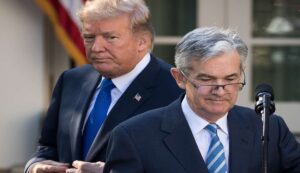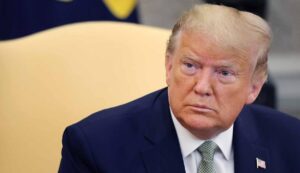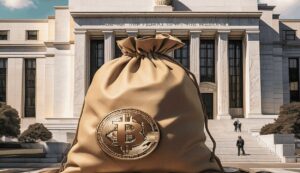US: Donald Trump opposes Federal Reserve’s decision to cut interest rates

The Fed’s decision, which is made just after 2:00 p.m. after a regularly scheduled meeting of its governors, would, by virtue of time, throw the central bank into the thick of an election campaign in which voters consistently name the economy as their top worry. Donald Trump, the former president, said that the Federal Reserve’s decision to cut rates, which would result in cheaper borrowing costs for consumers, is “something that they know they shouldn’t be doing” so close to an election.
However, this is not the opinion held by every Republican who supports Trump.
Politico revealed this week that a number of Republican lawmakers think the Fed should lower interest rates on a non-partisan basis.
The news source was informed by North Carolina Senator Thom Tillis that there is an “increasing body of work” indicating that rate cuts are warranted.
That’s how the Fed ought to function. It could be referred to as political. What matters to me is the impact it has on working families. And they urgently want assistance,” Tillis said.
Senator John Kennedy of Louisiana concurred, saying to Politico that “a rate cut is long overdue.” This economy is weakening very, very, very fast, especially in the job market.”
Republicans from Pennsylvania, including Representative Dan Meuser, told the news organization that the Fed has to “put the greater good ahead of looking political.”
In an interview, GOP strategist Brent Buchanan attacked the Fed’s anticipated action, stating that Republicans could be ready to disagree with Trump on interest rate reduction since the presidential election is more affected by macroeconomic policy than by contests for the Senate and House.
However, he suggested that Republican messaging stresses the need to address the economy “not by drastic last-minute measures aimed at changing political outcomes.”

“Republicans must take a stance and inform the Fed that they ought to have landed this aircraft earlier, before the election’s closing stages. And they’re playing politics right now,” he said.
Speaking in a more balanced manner, GOP strategist Matt Klink said that Republicans who support a reduction in interest rates are not necessarily trying to defy Trump but rather have a “difference of opinion” about whether the economy has slowed down.
When the Federal Reserve lowers interest rates fifty days before a presidential election, there will “always be divisions,” he told a media report.
Spokesman for the Republican National Committee Anna Kelly responded to the media report by blaming “Kamalanomics” for the “fastest increase in mortgage rates since 1981” and stating that Trump will “cut energy prices in half in 12 months and declare a national energy emergency to quickly bring down mortgage and interest rates.”
When it comes to its impending decision, the Federal Reserve is treading carefully. Central bankers are attempting to execute a “soft landing,” which refers to cutting rates too late to prevent a recession but too early to prevent inflation from rising again.
The Fed has made an effort to preserve its image as an apolitical organization and functions independently of the Congress and the White House. Fed Chair Jerome Powell will probably infuriate Trump by lowering interest rates this week. Trump has said on several occasions that the president ought to have direct authority over the central bank.
When considering whether to lower interest rates, the Federal Reserve should consider evidence rather than political issues, according to University of Michigan economics and public policy professor Justin Wolfers, who spoke with Newsweek. According to him, refusing to lower prices to avoid coming seen as political would be a political choice in and of itself.
“The best way to avoid appearing political is to not be political,” he said.
“That means reacting to the data instead of the election cycle or the demands of either side of politics,” he went on. Furthermore, the facts now indicate that we are stuck with excessively high interest rates. In order to reduce inflation, the Fed had to boost interest rates. Now, inflation is back to the Fed’s goal level. Thus, rate cuts by the Fed are required.”
While everyone agrees that the Fed shouldn’t be politically involved in decision-making, Robert Treist, an economics professor at Northeastern University and former vice president of the Federal Reserve Bank of Boston, pointed out that even taking the election into consideration would introduce politics into the picture.
“The case for rate reduction is quite strong; it would be politically incorrect to ignore the evidence, which suggests that rates should be lowered. Political factors would be the only explanation,” he said.
The Consumer Price Index, which is widely considered the benchmark for measuring inflation, increased by only 0.2 percent in August. This resulted in inflation reaching 2.5 percent, the lowest level since March 2021, and a little approach to the Federal Reserve’s 2 percent objective. The assumption that inflation is declining is supported by other recent economic data.
The Federal Reserve has previously changed interest rates in advance of elections.
Less than a week before election day in 2008, on October 29, the Federal Reserve slashed interest rates by 50 basis points, sending the economy into financial disaster with the failure of Lehman Brothers. On September 21, 2004, interest rates rose by 25 basis points.
Whether Wednesday’s drop will be 25 basis points or a bigger, 50 basis point move is a topic of debate among economists.
Powell dismissed in July the notion that the Fed would take any action driven by politics, even if it meant lowering interest rates before the election.
“Our undertaking is to make decisions when and as they need to be made, based on the data, the incoming data, the evolving outlook, and the balance of risks, and not in consideration of other factors, and that would include political factors,” he said before the House Financial Services Committee.
In election years, the Fed has a “long history” of being politically impartial, according to him, and it is “just not appropriate for us to get into the business of thinking about election cycles at all, one way or the other.”
According to Wolfers, it is “clear” that Wall Street now feels it is time to begin lowering rates based on inflation-indexed bonds and other market indications. He said that failing to do so would result in “too high” rates around the nation, endangering “our current economic recovery.”
According to Triest, the Fed was not certain that, even if inflation was down, it would still hit the 2 percent objective, which is why it did not begin lowering rates sooner. He said that the board wasn’t comfortable making layoffs at the time and needed additional information to consider, even though a case for them could have been presented during the July meeting.
September is different because of the job market’s apparent weakness, which makes an “increasingly strong case” for interest rate reductions.
“I think the big reason for the Fed to be cautious in cutting the federal funds rate is that they want to be very sure that everyone recognizes that the Fed is committed to a 2 percent interest rate target,” he said.
“If they did it before it was clear to everybody, that might have created the perception on the part of the public that the commitment wasn’t ironclad.”
But, he said, maintaining rates at the same level has drawbacks of its own. A bigger chance of a recession and the potential for a “more substantial increase in unemployment rate” than there otherwise would be are consequences of waiting too long. For the September meeting, Triest said that it is “quite clear” that the most recent data presents an “extremely strong case” for lowering the rates.
Wolfers and Triest delineated strategies by which the Federal Reserve may foster public trust in the United States that its choices are based on facts rather than politics.

Wolfers advised the central bank to “ignore the electoral calendar and follow the data.” Rates are being lowered; it ought to justify this. Furthermore, there is enough macroeconomic data available right now for it to be able to readily justify its actions.”
Triest went on to say that Jerome Powell may stress how the Fed makes decisions that are “very data-driven and that the Fed responds to” current data by using its macroeconomic expertise. According to him, they can identify the precise facts that supported their choice.
The election is not likely to be decided by the impending reduction, according to Klink, the Republican strategist. He continued, saying Republicans could portray the decrease as “too little, too late” and still link Democratic spending plans to rising food and interest rates.
“A quarter-point reduction is good, but it won’t benefit American consumers or homebuyers. The majority of voters, particularly in battleground areas, accuse Democrats of driving up costs. This fact raises serious concerns for Kamala Harris since people don’t think the Harris-Walz ticket will be able to solve their problems, according to Klink.
A rate-cut cycle is something that Harris and the Democrats would undoubtedly embrace coming into a tight election, but some members of the party have been urging Powell to do so for months.
Democrats who supported prior cutbacks include Senators Elizabeth Warren of Massachusetts and Sheldon Whitehouse of Rhode Island, who warned Powell in a letter from March that rising interest rates were driving up consumer energy bills.
Then, on Monday, Warren, Whitehouse, and Colorado Senator John Hickenlooper publicly asked Powell to decrease interest rates by 75 basis points, a reduction that is more than almost anybody had anticipated. The economy is “threatened and left the Fed behind the curve,” they added, citing the delays in rate-cutting.
“The Fed runs the unnecessary danger of sending our economy into a recession if it cuts rates too cautiously. Since July, many economists have alerted us to this danger,” they stated.